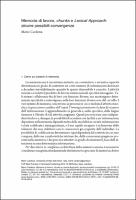Chapter Memoria di lavoro, chunks e Lexical Approach: alcune possibili convergenze
Abstract
Working memory is one of the most investigated topics in cognitive psychology and neuropsychology since it plays a key role in the architecture of cognitive human system. Reasoning, problem solving, and learning would be not possible without the contribution of working memory. Working memory is deeply involved in linguistic processes and in essential activities such as reading. Recent scientific research, especially in Anglo-Saxon context, has begun to investigate the role played by working memory not only in learning L1, but also in the acquisition processes of L2. Nevertheless, the overview of Italian language education still presents a lack of adequate literature on the important implications of the activity of working memory both for the theories of language learning and the practices of language teaching. This paper has the goal to identify some possible convergences between the working memory processes – especially of phonological loop and phonological memory – and the theoretical-practical system of Lexical Approach proposed by Lewis (1993; 1997). In this latter, specific attention is paid to the structure and learning of lexical chunks which are, according to Lewis, a fundamental element of the nature of lexicon and especially of collocations.


 Download
Download Web Shop
Web Shop